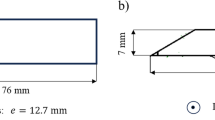Conclusions
Of the investigated low-alloy high-speed steels 11R3AM3F2 steel is closest to R6M5 steel in service characteristics and then R2M5 and 11M5F.
However, 11R3AM3F2 steel has poorer grindability than R6M5 steel and therefore its use in place of more highly alloyed steels is technically and economically desirable only for tools of simple form not requiring large amounts of grinding (saws for metal, cutters, etc.).
R2M5 steel may be a replacement for R6M5 steel for various tools in machining of comparatively easily machinable materials (low-alloy and carbon steels, gray iron, aluminum and copper base nonferrous metals, etc.).
11M5F steel, with its basic properties at the level of R2M5 steel, is characterized by a high tendency toward decarburization, oxidation, and mixed grain size in heat treatment, which requires high-quality hot working and heat treatment of the billets and tools for rational use of it.
ÉK41 and ÉK42 steels are significantly inferior to the above steels in all production characteristics and may not be considered as fully equivalent replacements for R6M5 steel. Narrow areas of use in which the reduction in life of the tool will not be significant may possibly be found for them. However, even such a use of these steels does not lead to economy in material and financial resources since it significantly complicates operation of the tool services.
In contrast to ÉK41 and ÉK42 steels, 11M5FYuS steel is promising together with R2M5 steel.
Similar content being viewed by others
Literature cited
E. S. Klein Rolf, "Praxis for derungen geben der Werkzeugschneidestoffentwicklung ständig neue impulse," Maschine,37, No. 9, 30–32 (1983).
S. I. Tishaev, B. É. Natapov, and V. V. Nakhabin, Improving the Structure of Production and Use of High-speed Steel. The Central Scientific-Research Institute for Information and Technical and Economic Investigations on Material and Technical Procurement: Review Information, Series 5. Rational Use of Materials Resources [in Russian], No. 7 (1982).
B. Fredereksson and M. Attlegard, Semi-high-speed Steels with High-speed Performance. Steel Research, S77301, Fagersta AB, Fagersta (1982).
R. Bennecke, P. Gümpel, and K. Köster, "Entwicklung eines niederiglegierten Schnellarbeitsstahles," in: Thyssen Edelstahl Technische Berichte, No. 2 (1983), pp. 96–102.
Yu. N. Vnukov, V. P. Komarov, and A. S. Uchaev, "The grindability of new types of highspeed steel," Tekh. Org. Proizvod., No. 3, 22 (1983).
L. S. Kremnev, A. M. Adaskin, and V. V. Tumenko, "The influence of chemical composition and heat treat conditions on the grindability of high-speed steels," Metalloved. Term. Obrab. Met., No. 5, 14–15 (1983).
Additional information
Ukrainian Scientific-Research Institute for Special Steel. Translated from Metallovedenie i Termicheskaya Obrabotka Metallov, No. 5, pp. 51–55, May, 1988.
Rights and permissions
About this article
Cite this article
Natapov, B.É., Tishaev, S.I., Skrynchenko, Y.M. et al. Properties and rational use of low-alloy high-speed steels. Met Sci Heat Treat 30, 381–386 (1988). https://doi.org/10.1007/BF00701051
Issue Date:
DOI: https://doi.org/10.1007/BF00701051




